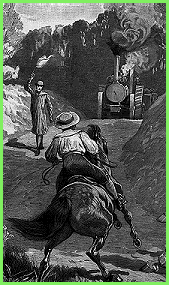Steam power
on the road
in 1884
Notice
the man
in front with
a red flag !
You could probably
hear the thing
coming for miles !

As steam engines for the railways were steadily improved in the Victorian age, there were also trials of different types of steam powered wagons for use on the road. But the turnpike trusts did not want these 'steam carriages' to use their roads at all.
When the toll charges were revised as part of the 1834 Turnpike Act for Montgomeryshire the tolls for any machine not pulled by animals were set at a rate high enough to keep them off the roads.
